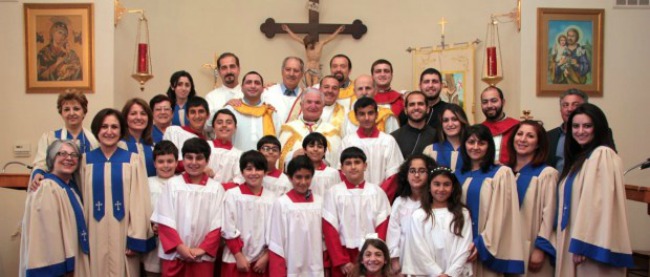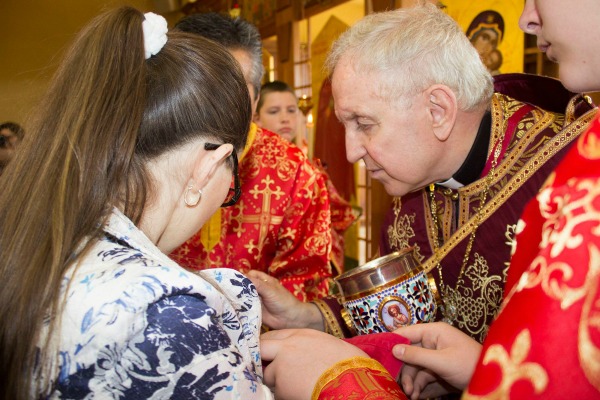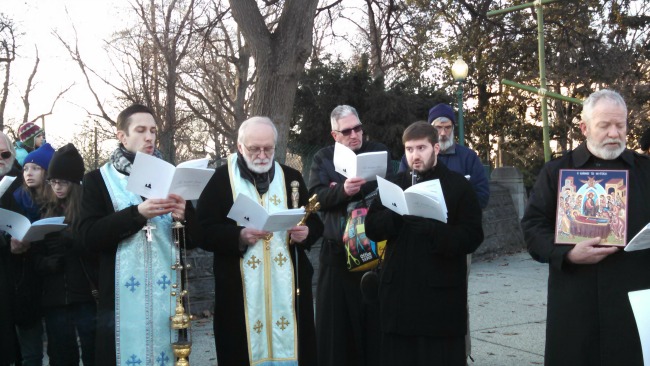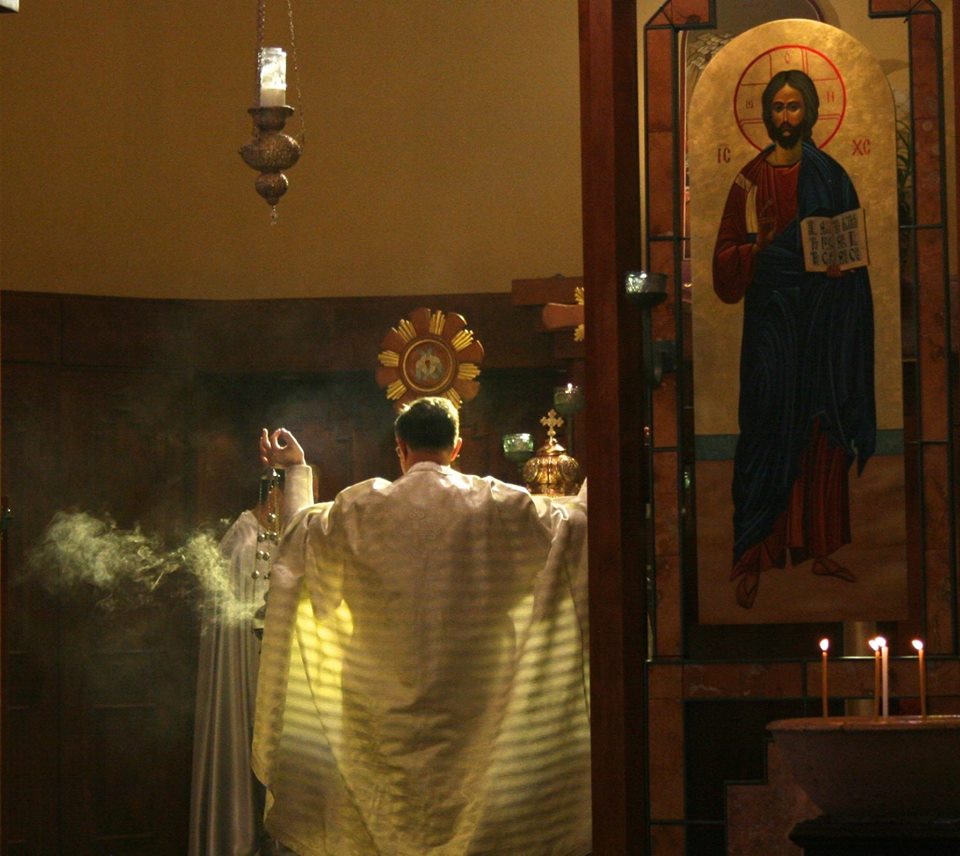Eastern Catholic Bishops Made ‘Light of the East’ Burn Brighter in the US
Three just-retired Eastern-Catholic bishops worked tirelessly to evangelize with the spiritual treasures of the Chaldean and Byzantine traditions.
![Above: Bishop Sarhad Yawsip Jammo at a diaconal ordination. Below in descending order: [first photo] Bishop Jammo with parishioners at St. Mary's Church in Campbell; [second photo] Bishop Gerald Dino confers the sacraments of initiation on an infant; [third photo] Bishop John Kudrick leads youth in chanting a traditional Marian hymn at the March for Life 2015; [fourth photo] a Byzantine Catholic priest offers the Divine Liturgy. Above: Bishop Sarhad Yawsip Jammo at a diaconal ordination. Below in descending order: [first photo] Bishop Jammo with parishioners at St. Mary's Church in Campbell; [second photo] Bishop Gerald Dino confers the sacraments of initiation on an infant; [third photo] Bishop John Kudrick leads youth in chanting a traditional Marian hymn at the March for Life 2015; [fourth photo] a Byzantine Catholic priest offers the Divine Liturgy.](https://publisher-ncreg.s3.us-east-2.amazonaws.com/pb-ncregister/swp/hv9hms/media/20200828120844_5f48e097c2bf74d8cce43eb0jpeg.jpeg)
SAN DIEGO — When St. John Paul II gave Bishop Sarhad Jammo the newly created Chaldean Catholic Diocese of St. Peter the Apostle, he laid a monumental task upon the new bishop: tend to the diaspora of Catholics from Iraq, and give the East’s ancient faith of martyrs’ deep roots in the spiritually thirsty soil of California and the western United States.
Bishop Jammo’s 14 years of labors as the Chaldean diocese’s first bishop came to an end when he reached the mandatory retirement age of 75. The May 7 bulletin announcing Pope Francis had accepted his retirement also contained the names of two other newly retired Eastern-Catholic bishops: Bishop Gerald Dino, the bishop of the Byzantine Catholic Eparchy of Phoenix; and Bishop John Kudrick, the bishop of the Byzantine Catholic Eparchy of Parma, Ohio.
All three bishops labored to fulfill St. John Paul II’s wish that they plant the “Light of the East” in a Western society choked by materialism and hungering for a true taste of the divine mysteries of the Catholic faith.
Bishop Jammo was consecrated the first bishop of the St. Peter the Apostle Diocese, based in El Cajon, Calif., in July 2002. The diocese was created to accommodate the Western U.S.’ growing population of Chaldean Catholics, who belong to the Church founded by St. Thomas the Apostle in present-day Iraq. Within five years, the diocese began receiving part of the massive influx of Chaldean-Catholic refugees escaping the sectarian violence of Iraq’s civil war.
“He’s rather a hero of mine,” said Father Andrew Younan, director of the Chaldean Media Center, who told the Register he worked closely with the bishop over the years.
Father Younan explained that, within 14 years, Bishop Jammo established several new parishes, a seminary, a convent for Chaldean nuns and a monastery for celibate monks. The diocese also established a robust online presence, the Chaldean Media Center, and Kaldu Television, which livestreams the Divine Liturgy and prayers.
“He’s also the central figure in the reform of the Chaldean liturgy,” Father Younan said. Bishop Jammo also translated the Chaldean Church’s liturgy and prayers into English, equipping it to hand on its ancient patrimony of liturgy, prayer and spirituality to future generations of Chaldean Catholics, including to men and women wandering amid an American materialist culture looking for real spiritual intimacy with Jesus Christ.
He added that Bishop Jammo instilled in the diocese a deep appreciation of their Church’s spiritual heritage and history, which goes back to the apostles Thomas and Jude Thaddeus and was never the official religion of any state.
“We have a Church that is full of the blood of martyrs who gave their lives throughout all of history,” he said. “He wants us to understand that, appreciate it and be who were are.”

‘We Have the Faith of Martyrs’
Joyce Coronel, a Catholic journalist working for The Catholic Sun, the newspaper of the Diocese of Phoenix, wrote her novel A Martyr’s Crown based on her two years of interviews with Chaldean Catholics in the Southwest. She told the Register that her experience of Chaldean-Catholic spirituality — thanks to their witness and the new English translations of their ancient hymns, the Liturgy of the Hours and prayers spoken by its martyrs — deeply enriches her own faith. The Chaldean Holy Mass, also known as the Divine Mysteries, radiates the “beauty of the East,” she added.
“I had not really suffered for my faith — these people have suffered,” said Coronel, who belongs to the Latin Church. “They’ve made me a better Catholic.”
She recalled one conversation she had with Bishop Jammo, where she told him about all the help that Catholics in the Diocese of Phoenix could provide his diocese, when he smiled and stopped her for a moment.
“He said, ‘That’s all good, but you need our help, too. We have the faith of martyrs, and we have an ancient heritage that we would love to share with you,’” Coronel recounted.
During Bishop Jammo’s tenure, many families from the Assyrian Church of the East led by Bishop Bawai Soro (now the diocese’s vicar general) entered into communion with the Chaldean Catholic Church, and they merged with their parishes.
Toward the end of his time as bishop, he had tried — with mixed results — to keep in his diocese some priests who had been alleged to have emigrated from Iraq without proper authorization from the Chaldean patriarch. However, Patriarch Louis Raphael Sako wrote an open letter to the diocese May 10 expressing his “gratitude” for Bishop Jammo’s service, his many accomplishments, and hoped that he would continue his scholarly work. He asked that the diocese and the mother church “put the past behind” in the spirit of the Year of Mercy and “open new page” in their relationship.
Mark Arabo, a prominent Chaldean businessman in the San Diego area, who worked with the bishop in supporting the victims of ISIS, said Bishop Jammo is “a monumental figure within our church and community.” Arabo noted that the bishop led the diocese “through both challenge and triumph,” and his efforts “will remain visible for generations to come.”
“He leaves footprints that his successors will only hope to fill,” Arabo said.
Byzantine Mysticism in the Southwest

Eastern Catholic Churches in the U.S. account for 1% of the overall Catholic population, but they are evangelizing the country with the treasures of their spiritual patrimony. Although small in size, the Byzantine Church has been in a process of following the decree of the Second Vatican Council to restore its Eastern traditions (after centuries of pressure to adopt Latin-rite customs) and to take its place as evangelizers co-equal in status and dignity with the Latin Church headed by the Bishop of Rome.
The Byzantine Church in the U.S.’ two newly retired bishops, Bishops Dino and Kudrick, advanced the Church’s mission during their time of service, by strengthening Byzantine-Catholic spirituality and identity in parishes and among youth and by bringing people into the Church who are drawn to encounter Jesus Christ through the Byzantine tradition.
Bishop Dino’s Eparchy of Phoenix stretches along the West Coast, from Alaska all the way down to Arizona, and the bishop has constantly traveled to the Byzantine-Catholic communities in between. But while small in total population, a number of communities show how the Byzantine tradition is no longer constrained by ethnic boundaries, but has planted its life firmly in the American context and is accessible to all.
“As a result, people of various ethnic backgrounds have migrated to us, who are interested in Byzantine liturgy, theology and spirituality,” Bishop Dino told the Register. For example, the rector of the cathedral is Hispanic, and so are several deacons and priests of the eparchy, but what makes them all one is their shared Byzantine identity.
In an effort to make the Byzantine tradition more widely known, the eparchy’s website now hosts a virtual “Byzantine 101” library and offers online faith formation.
“A lot of people have questions about the Byzantine-Catholic traditions,” he said, adding what draws them in: iconography “and the presence of God and the saints in these icons.”
Byzantine Tradition in the Midwest
Unlike Bishop Dino, who had reached the mandatory retirement age of 75, Bishop Kudrick was 68 when Pope Francis accepted his resignation. Bishop Kudrick had led the Parma Eparchy, which stretches over 12 Midwest states, with 30 church communities and 8,000 faithful, since 2002.
During this time, Bishop Kudrick, a Third Order Franciscan, worked to plant the Eastern tradition of monasticism in the U.S. He succeeded in establishing a growing community of Byzantine Catholic nuns at Christ the Bridegroom Monastery in Burton, Ohio, but his dream of establishing a Byzantine monastery for men had not been achieved by his retirement. The Byzantine Church has both married priests — ordained married men who remain celibate upon the death of their spouse — and celibate priests. The celibate priests in the U.S. typically live in parish rectories, but in the Eastern tradition, celibate priests are ideally meant to live a monastic life, and a bishop is chosen from the ranks of the monks.
“We’re very grateful for Bishop John’s retirement, but we know it will not stop him from a new phase of episcopal ministry, and it will not stop the great work he has done for the Eparchy of Parma,” Father Andrew Summerson, communications director for the Eparchy of Parma, told the Register. “He created a terrific culture of prayer and service throughout the eparchy, and a great number of initiatives he has begun will survive him.”
Bishop Kudrick, during his travels, promoted the Byzantine tradition of morning and evening prayer in parishes. The bishop could be seen with eparchy youth at the March for Life chanting the beautiful Akathist hymn, a traditional Byzantine prayer honoring the Blessed Mother. He also encouraged the formation of Byzantine Catholic youth with the ByzanTeen boys’ camp and girls’ camp.
“We call them ascetical camps for young men and women, but, basically, it’s an attempt to model the fullness of the Church: the prayers, the fasts and learning how to be men and women of faith,” Father Summerson said. “Bishop John certainly cared about young people, and in trying to model the fullness of the Church in your young people, you’re really raising up the kind of Byzantine-Catholic Church you want to see.”

Father Thomas Loya, host of Light of the East Radio and pastor of Annunciation Byzantine Catholic Church in Homer Glen, Ill., told the Register that Bishop Kudrick’s successor will have to confront the evangelical challenges facing the eparchy due to demographic shifts: The families are smaller, and new generations of Byzantine Catholics have moved from the industrial cities, such as Cleveland, to metropolitan areas fueled by the new economy of communications and service industries, such as Omaha, Neb., and Columbus, Ohio.
“We have populations there that are calling to us,” he said, saying it will require a “creative response” to address these new realities, so that they can continue to expand and spread the Gospel.
“We’re at the point where we have to enter major renewal,” he said.
The Light of the East
Father Loya explained that what the Eastern Churches bring to the Church’s evangelization in the U.S. is a profound awareness of the mystical nature of the Christian faith, and they can feed a spiritual hunger felt in a climate that has become both materialistic and looking for the “mystical” in all the wrong places. The very people who need to experience the mysticism of Eastern Christianity are instead searching for an empty Eastern mysticism in California, he explained. He said that St. John Paul II, in his 1995 apostolic letter Orientale Lumen (Light of the East), made clear that Latin Catholics need to become familiar with the Eastern Churches and avail themselves of their spiritual riches.
“Eastern-Christian spirituality is the round peg that will fit in the round hole in the soul of Western civilization,” he said, quoting G.K. Chesterton’s insight that “mysticism is what keeps men sane.”
“Let’s face it, in modern Western culture, we have a lot of insanity,” the priest said. Western Christianity is more “cerebral” in its approach, Father Loya said, while the East is much more experiential. And while the West has a mystical tradition that engages the five senses in its liturgical life, “The East does it to a further degree,” with mysticism permeating its liturgy, art, architecture and teaching.
“Mysticism is living in the both-and: something revealed and something hidden at the same time,” he said. It helps teach people that God is both “righteous judge” and “lover of mankind” — transcendent from creation, but intimate with human beings — when the Western mindset would rather put those concepts in opposition to each other.
But Father Loya said today’s challenges of evangelization in the West just show how much the West and the East need each other’s gifts, working together as the “two lungs of the Church.”
He said, “The East needs the gifts of the West, but the West also needs the gifts of the East.”

Peter Jesserer Smith is a Register staff reporter.
- Keywords:
- bishop gerald dino
- bishop john kudrick
- bishop sarhad jammo
- byzantine catholic church
- chaldean catholic church
- chaldean catholic diocese of st. peter the apostle
- chaldean church
- chaldean diocese
- divine liturgy
- eastern catholic bishops
- eastern catholics
- eparchy of phoenix
- mysticism
- patriarch sako
- peter jesserer smith

















